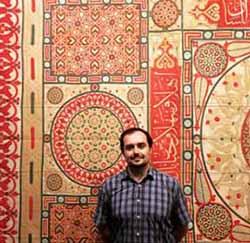* Leading CSU Islamic art expert spoke at Iftar dinner* in Canberra on Friday 18 May
* ‘The Art of Living Together’ reflects on how art can bring people together
* Art is a lens for cultural interpretation; it is inclusive, insightful, and inspiring

Dr Sam Bowker, lecturer in art history and visual culture in the CSU School of Communication and Creative Industries in Wagga Wagga, spoke on ‘The Art of Living Together’.
Dr Bowker said, “I reflected on how art brings people together and is inclusive. I discussed the importance of teaching Islamic art in Australia. The title refers to Dr Martin Luther King and others in relation to the exhibition ‘So You May Know Each Other’ at the NMA.
“The presentation included reflections on my own experiences while developing ART240: Introduction to Islamic Art and Design for CSU. I shared some experiences from our diverse students, as well as what they have taught me.
“It’s an important field because it is arguably the largest genre in art history − chronologically and geographically. No-one else is currently teaching it as a survey for Australian undergraduates,” he said.
Dr Bowker shared stories from teaching and travelling with his students, who, supported by the Australian Government’s New Colombo Plan, served as scholars-in-residence at the Islamic Art Museum Malaysia.
“They are a remarkably diverse scholarly group, from a range of disciplines in the humanities, education, Islamic studies, theology, animation, photography, graphic design, and business,” Dr Bowker said.
“Through these immersive expeditions these students have forged friendships, inspired new travels, and created ongoing creative projects with partners in Malaysia and beyond, all driven by the recognition that art is a lens for cultural interpretation and understanding.”
Dr Bowker also shared insights provided by visitors to exhibitions he has curated, specifically the contemporary digital arts exhibition Echoes and Identity: What is Contemporary Islamic Art? in Melbourne, and the major survey exhibition Khayamiya: Khedival to Contemporary in Kuala Lumpur.
“These impressions noted how profoundly we can be moved by artworks, the conversations they inspire, and the relationships they can form as meaningful extended engagements rather than brief events,” he said.
“These exhibitions are created to promote the future of these art forms, even if the artifacts displayed are centuries old. These encounters are intended to inspire action, not just reflection.”
Dr Bowker said this informs the importance of engaging communities with art.
“To explain this I drew on impressive case studies from art history and contemporary art, which included, among others, the textile arts of the Egyptian Tentmakers and el Seed’s Perception in Cairo,” Dr Bowker said. “This is a vast ‘calligraffiti’ urban mural (or multi-building installation) that was intended to change attitudes toward the Zabaleen, a primarily Coptic Christian community in Cairo, historically responsible for the recycling of this enormous city’s waste.”
Dr Bowker concluded by noting Australian contributions to the field of Islamic art, and what might yet be done by scholars, artists, designers, teachers and curators, as they work towards ‘the art of living together’.





Social
Explore the world of social